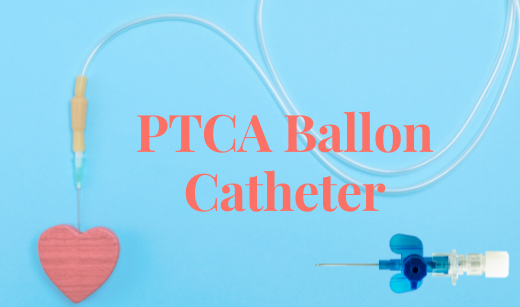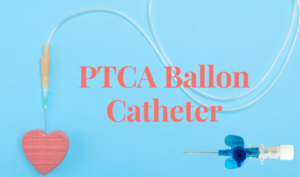PTCA Ballon Catheter
Balloon catheters are used for a variety of minimally invasive diagnostic and therapeutic treatments, such as dilating arteries, opening obstructions, and delivering stents. Angioplasty balloon catheters are used either Over-the-Wire (OTW) or Rapid Exchange (Rx) in design. A plain old balloon angioplasty or POBA, is used when a balloon catheter is used to compress plaque within a congested coronary artery. Balloon catheters are also used to place stents during angioplasty procedures. Balloon catheters are sent to the cath lab with a stent already attached. The stent extends as the cardiologist inflates the balloon.
Balloon catheters for angioplasty
Angioplasty balloon catheters are either Over-the-Wire (OTW) or Rapid Exchange (Rx) in design. Rx catheters now account for roughly 90% of the market for coronary intervention. OTW Catheters are still effective in very tortuous vascular paths, although they have a longer deflation time and are less pushable. A plain old balloon angioplasty, or POBA, is when a balloon catheter is used to compress plaque within a congested coronary artery. Balloon catheters are also used to place stents during angioplasty procedures. Balloon catheters are sent to the cath lab with a stent already attached. The stent extends as the cardiologist inflates the balloon. The stent remains in the artery when the cardiologist deflates the balloon, and the balloon catheter can be withdrawn. In contrast to self-expandable stents, which are primarily constructed of Nitinol alloy, balloon expandable stents are utilised in conjunction with a balloon catheter.
Balloon Types
There are three main types of balloons:
- Noncompliant (high-pressure) balloons are typically made of polyester or nylon. They’re used for applications in which the balloon needs to expand to a specific diameter and exert high pressure to open a blockage or dilate the vasculature.
- Semicompliant (midpressure) balloons are commonly made of Pebax or higher-durometer polyurethanes. They’re used in applications in which you need mid-high pressures but want more compliance than a non-compliant balloon and more flexibility to ease delivery.
- Compliant (elastomeric) balloons are typically made of polyurethane or silicone. They are inflated by volume, rather than pressure. Able to stretch 100% to 800%, they are often used in applications that require the balloon to fully conform to or occlude the anatomy.
Catheter Types
To achieve the column strength required to insert and advance the catheter into position, most balloon catheters require support. Catheters are typically designed in one of three ways:
- Over-the-wire (OTW) balloon catheters feature a guidewire that tracks along the full length of the catheter.
- Rapid exchange (RX) balloon catheters have a guidewire along only a short section (about 25cm), saving time compared with advancing a guidewire through the full length of the catheter.
- Fixed-wire (FW) balloon catheters have a wire core built inside the catheter, eliminating the need for a guidewire to advance the catheter to the treatment site.
Applications
The application for which the catheter will be used is the primary driver of catheter design. Common applications for balloon catheters include:
- Renal denervation
- Cryoablation
- Balloon sinuplasty
- Transcatheter aortic valve implantation (TAVI)
- Drug delivery
- Stent delivery
- Balloon occlusion
- Balloon angioplasty
- Esophageal dilation
- Atherectomy
- Balloon carpal tunnelplasty
- Kyphoplasty
PTCA Cathers imported by Morulaa

- The Simpass™ HP-NC RX PTCA Balloon Dilatation Catheter is indicated for balloon dilatation of the stenotic portion of a coronary artery for the purpose of improving myocardial perfusion.
- The Simpass™ HP-NC RX PTCA Balloon Dilatation Catheter is designed to be used in pre and post-dilation during stent procedures and also recommended to dilate for calcified stenotic atherosclerotic lesions in coronary arteries or bypass grafts with a high pressure applications..
- Tighten the hemostasis valve to create a seal around the dilatation catheter without preventing movement of the catheter. This will allow continuous recording of proximal coronary artery pressure.
Conclusion
Simpass PTCA Balloon Dilatation Catheter by Simeks is a PTCA catheter medical device approved by CDSCO in India. This article deals with the types, uses and applications, and other relevant information that needs to be known by the dealers and distributors. This PTCA catheter like Abbott’s is based on similar principles. Simpass PTCA Balloon Dilatation Catheter by Simeks is an excellent medical device that can be used to diagnostic and therapeutic procedures. It is a product imported by Morulaa and may be considered as a good alternative to other PTCA Ballon Catheters from Cook medical.
This article is intended to give product information on PTCA Ballon Catheters . To know more about the product details, brochure please visit products.morulaa.com.
Morulaa is a turnkey solution provider with an in-house Regulatory Consultancy team to conduct registrations of medical devices. Morulaa provides high-quality and professional services for Regulatory Consultancy and we aim at developing long-term relationships for the Indian Market.






